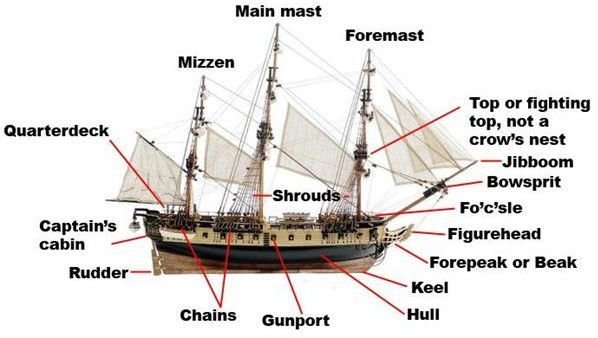Ship Design - What are the Parts of a Sailing Ship?
Design and Components of Sailing Ships
Today sailing is done mostly for pleasure and sailors want the best quality boat in order to enjoy the day out with their friends and family. Please note that the term sailor here does not refer to commercial sailors or seamen but rather to the causal boater.
So, what are the parts of a sailing ship that are most important and why? This will be described below to give you a better understanding of what you need to consider before buying or building a sailboat. It is important to understand their significance for your safety and to avoid any unwanted accidents while having fun.
It is imperative to use the best materials and methods to provide safety and durability for the sailor’s satisfaction. To do this as effectively as possible, the design must be directed toward certain components:
Sail ships move using the force of the wind. By placing sails across the path of the wind, it pushes against them to create a force which, in turn moves the vessel. This means that the design requires the following:
A strong hull- the hull of many boats is built strong to withstand the powerful force of the waves. In the case of a sail ship there is another feature that adds to the strain on the hull, namely the masts. They hold the sails thus exerting huge amounts of force on the hull. For the hull to be strong and not rupture while sailing, the hull needs to be reinforced around the mast area.
The mast - it could be responsible for holding up to three sails at a time thus requires to be very strong and flexible. This is the component of the vessel that powers it, so it is very important that the mast be strong to avoid breakage. If the mast was weak and was to break in the open sea the sailors would most certainly be stranded until a rescue team found them.
Sails- the winds exert force against the sails and, as such, produce the main source for propulsion. For this reason, the best quality material is used to make a good sail. Both the Main sail and the Jib sail are very important as a form of propulsion. Beside the sail material there are the rope fastening hooks and rings that need to be strongly stitched to avoid inconvenience that may occur.
Center board- plays an important part to counter the force of the sail from turning over the boat. It is an important part of smaller sail ships and most of them will have it. It can be found as permanent or temporary fixtures that can be adjusted to suite the wind pressure. The center board is an important part of smaller and lighter vessels since it help counter the wind force on the sails to stop the vessel from turning over and sinking.
Rudder- with the wind force pushing continually a sail boat must have a form of steering. Older vessels did not have this component but modern vessels have added this feature. Without the rudder the ship would just drift with the wind, rudders help control the vessel as it moves. Rudders also have extensions that can be added reaching near the mast. They are known as tiller extension. It is useful when the sailor is doing something near the sail and he can maintain control of the ship.
Body material- unlike the past when sailboats where made using wood, today many artificial materials can be used to make stronger hulls. Light weight and strength are the two most important factors in today’s hull construction. People want to move faster without damaging there vessel. Fiberglass has replaced steel which is rarely used to construct leisure craft today.
These are some important parts that we should consider before builds or buying a sail boat. There are many smaller components that make up a good sailing ship such as the anchoring hooks for the Forestay and the sails, the Jib sheet- a rope that supports the mast- among many other aspects. So with these few pointers I hope you have learned what parts of a sailing ship that are the most important and next time you go out sailboat shopping, you will consider taking a good look at these things before making up your mind.
Design and Components of Sailing Ships
References
Robert Brien (1986) Model Sailing Ships: Design and Construction. London: Batsford Ltd.
John, D. Whidden (2006) Ocean Life in the Old Sailing-Ship Days: From Forecastle to Quarter-Deck
Model-dockyard.com
